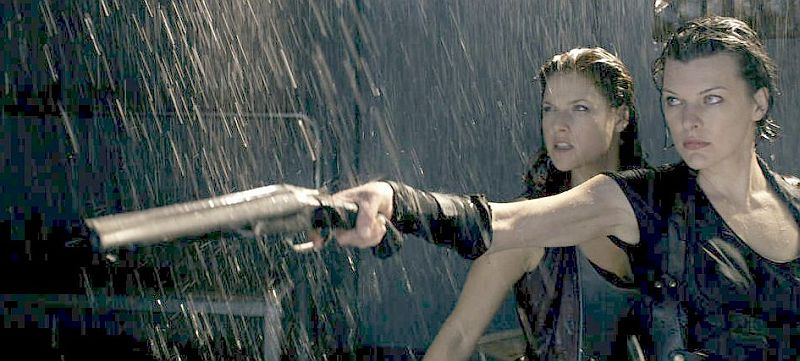
★★★
“Is There Life After Afterlife?”
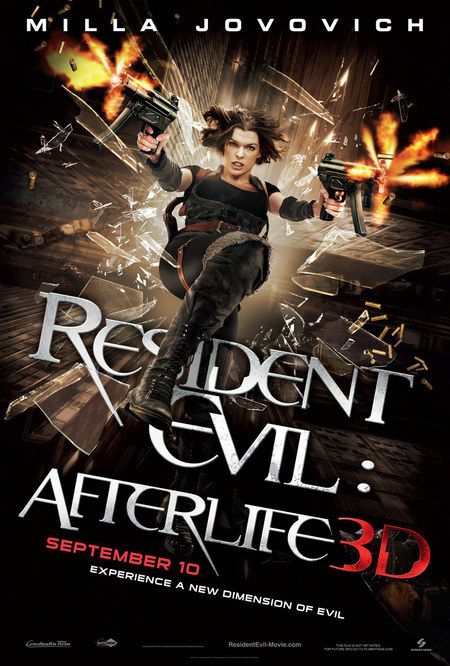 Milla Jovovich, coming at you in three dimensions! Unfortunately, Chris and 3D movies do not play well with each other – as we discovered at Avatar, where the resulting motion sickness had her staring at the back of the seat in front, after the first twenty minutes. She understandably declined all invitations to see Afterlife in this mode, so please note that with regard to this review, we’re strictly discussing the 2-D version. Other reports generally indicate the 3-D is pretty spiffy, having actually been shot that way, rather than being some hacked conversion job like certain movies I could mention [cough-ClashoftheTitans-cough]. That said, we move on.
Milla Jovovich, coming at you in three dimensions! Unfortunately, Chris and 3D movies do not play well with each other – as we discovered at Avatar, where the resulting motion sickness had her staring at the back of the seat in front, after the first twenty minutes. She understandably declined all invitations to see Afterlife in this mode, so please note that with regard to this review, we’re strictly discussing the 2-D version. Other reports generally indicate the 3-D is pretty spiffy, having actually been shot that way, rather than being some hacked conversion job like certain movies I could mention [cough-ClashoftheTitans-cough]. That said, we move on.
We keep bumping into the first Resident Evil movie, which has been on cable a lot lately, and I’m tending to think my 3 1/2-star review was an under-estimate. Maybe due to the underwhelming nature of the last couple of entries in the series, the original moves briskly, keeps a tight focus on proceedings, and has a nice character arc for Alice. I was hoping that the return of its creator, Paul W.S. Anderson, to writing and directing for this fourth installment would signal a return to this approach.
There’s really only one reason we bother with this series: to see Milla Jovovich kicking righteous ass. Everything else is – or should be – secondary. And for the first 15 minutes, it looked like this would indeed be a return to these basics, as Alice and an army of Alice-clones launched a righteous assault on the massive complex housing the Umbrella Corporation’s headquarters beneath Tokyo. It’s reminiscent of the lobby scene from The Matrix, with a swarm of Alice-alikes breaking in and hurling themselves against the guards like aggrieved lemmings, with no regard for their personal safety, as they try to take out Umbrella’s CEO’s Albert Wesker (Roberts).
It’s great: among the best scenes of the entire series, in fact. The bad news is, it’s also the best thing in the movie. The sequence would have made a great climax, but instead, everything thereafter feels like an anti-climax. Wesker escapes by helicopter, flipping the self-destruct switch and destroying the clones. However, the real Alice is aboard, and before the ‘copter crashes, he injects her with a serum that neutralizes the T-virus, rendering her human again. Boooooo-ring! Turns out they both survive the crash: quite why Wesker didn’t deal with her then, isn’t made clear. Alice heads to Alaska, in search of the haven called Arcadia where Claire Redfield (Larter) was heading at the end of the third film.
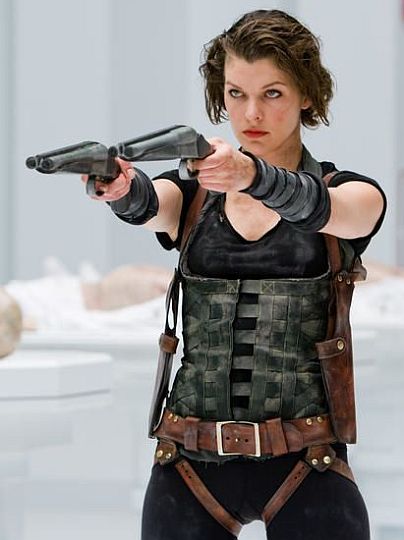 That turns out to be a red herring, but Alice does find Claire, albeit now controlled by an Umbrella device on her chest. Removing that, albeit at the cost of Claire’s memory, the pair fly back down the West coast, eventually locating a group of survivors bunkered down in an LA prison – Arcadia turns out to be the name of a boat, anchored just offshore. As the zombies break in, the survivors make their way towards the boat, with the help of a prisoner who turns out to be Chris (Miller), Claire’s brother. Reaching the Arcadia, they discover it’s a trap, designed to lure people to it for Umbrella’s research, with Wesker overseeing operations. He wants to assimilate (or “eat”) Alice; as the only person to successfully meld with the T-virus, he wants that ability to enhance his own superpowers.
That turns out to be a red herring, but Alice does find Claire, albeit now controlled by an Umbrella device on her chest. Removing that, albeit at the cost of Claire’s memory, the pair fly back down the West coast, eventually locating a group of survivors bunkered down in an LA prison – Arcadia turns out to be the name of a boat, anchored just offshore. As the zombies break in, the survivors make their way towards the boat, with the help of a prisoner who turns out to be Chris (Miller), Claire’s brother. Reaching the Arcadia, they discover it’s a trap, designed to lure people to it for Umbrella’s research, with Wesker overseeing operations. He wants to assimilate (or “eat”) Alice; as the only person to successfully meld with the T-virus, he wants that ability to enhance his own superpowers.
There’s way too much moving about in underground darkness here, and elements are lobbed in from the video game, which make no sense in the context of the movie. For instance, some zombies now have their faces split open and become all tenticular: why, is never explained, and the CGI used here is less effective than the effects used for a similar concept in Blade II, almost a decade ago. There’s also the Executioner, a giant creature wielding an even-larger weapon: again, its presence from a cinematic perspective is completely unexplained. In short, the film just doesn’t make much sense, though admittedly, between the battles, there was precious little of interest going on to hold my attention.
Nor is there much feeling of threat to the characters, who cheat death with blithe abandon – the sense of “anyone can die, at any time” present in the original is all but gone. A case in point would be the leader of the survivors, who vanished from the film entirely as they make their way out of the prison, only to reappear, right at the end, to no point whatsoever. Chris Redfield is an almost entirely superfluous character; like the monsters mentioned above, he is apparently there, just so that fans of the game can go “Look! It’s Chris Redfield!” The rest of us…not so much. The whole subplot of Alice’s humanity being restored doesn’t go anywhere either; that may well be fortunate. In any case, by the end, she seems completely back to normal. Well, “normal” in the way we want to see, anyway.
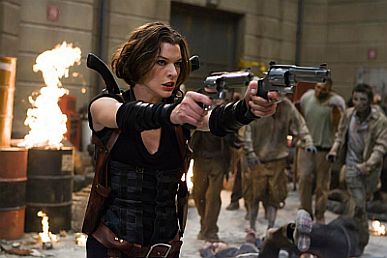 Which brings me nicely to the action, and it is, as usual for the series, solid, meaning this is, overall, just worth the 92 minutes of your time it will take up. I think due to the 3-D, the editing is more restrained than it has been of late; indeed, there’s probably as much slow-motion as anything else. I particularly liked Alice’s fondness for loading her shotgun with coins – again, I suspect largely for 3-D purposes. There’s a nice tag-match between her, Claire and the Executioner, but the final face-off versus Wesker is largely forgettable. As usual, the film ends on an interesting note: this time, it’s the return of a character last seen in Apocalypse, who makes a cameo early in the end-credits, and I wouldn’t mind seeing them return.
Which brings me nicely to the action, and it is, as usual for the series, solid, meaning this is, overall, just worth the 92 minutes of your time it will take up. I think due to the 3-D, the editing is more restrained than it has been of late; indeed, there’s probably as much slow-motion as anything else. I particularly liked Alice’s fondness for loading her shotgun with coins – again, I suspect largely for 3-D purposes. There’s a nice tag-match between her, Claire and the Executioner, but the final face-off versus Wesker is largely forgettable. As usual, the film ends on an interesting note: this time, it’s the return of a character last seen in Apocalypse, who makes a cameo early in the end-credits, and I wouldn’t mind seeing them return.
Despite the 3-D, the movie was only a mediocre success here, but a much greater hit overseas. For perspective, the percentage of total box-office coming outside North America for the first three entries was fairly constant, at 61%, 60% and 66% respectively. Afterlife got an astonishing 80% of its takings in foreign territories, grossing $236 million there, compared to only $60m in the US, barely recovering its budget. That’s one of the highest ratios of the year, and has only been surpassed a handful of times this decade, by films with a broad Stateside release. It’s this success abroad which means a fifth installment is all but certain. And as long as they keep making them, we’ll keep watching, hoping the potential, seen in flashes, might be more fully realized. A script which makes sense on its own terms, and doesn’t bother pandering to gamers, would be a good start.
Dir: Paul W.S. Anderson
Stars: Milla Jovovich, Ali Larter, Wentworth Miller, Shawn Roberts





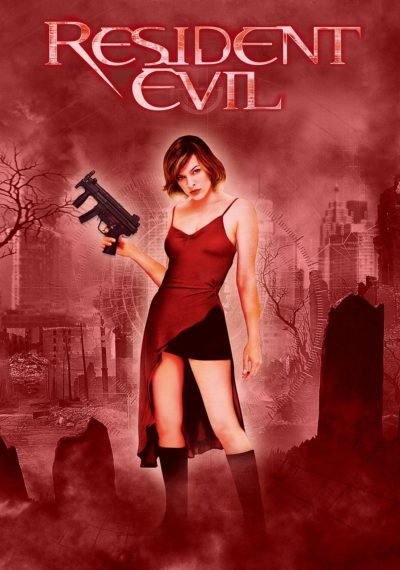 Resident Evil (2002)
Resident Evil (2002)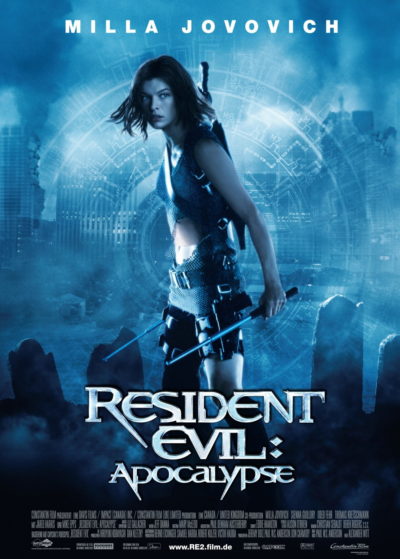 Resident Evil: Apocalypse (2004)
Resident Evil: Apocalypse (2004) Resident Evil: Extinction (2007)
Resident Evil: Extinction (2007)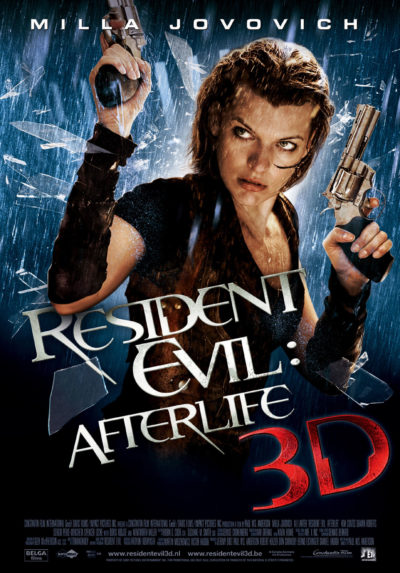 Resident Evil: Afterlife (2010)
Resident Evil: Afterlife (2010)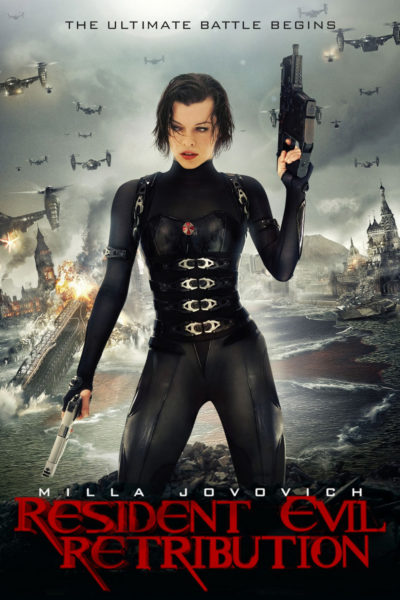 Resident Evil: Retribution (2012)
Resident Evil: Retribution (2012) We’d skipped the last two installments at the movies, having been burned by part three, but after the excellent content of #5, and since this was likely to be our last chance, Chris and I made it a “dinner and a movie” thing on Saturday. Was disturbed by how many kids there were for this R-rated film – hell, even a couple of babes in arms, whom I’m sure loved the non-stop violence. I guess it was deemed kid-friendly by their parents, with this one getting its MPAA rating just “
We’d skipped the last two installments at the movies, having been burned by part three, but after the excellent content of #5, and since this was likely to be our last chance, Chris and I made it a “dinner and a movie” thing on Saturday. Was disturbed by how many kids there were for this R-rated film – hell, even a couple of babes in arms, whom I’m sure loved the non-stop violence. I guess it was deemed kid-friendly by their parents, with this one getting its MPAA rating just “


















 ★★★★
★★★★ While being (again) largely disappointed by the previous entry, Afterlife,
While being (again) largely disappointed by the previous entry, Afterlife, 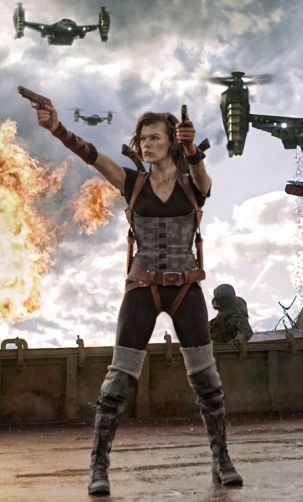 Though actually, this is almost a “greatest hits” package, especially in terms of participants. Not seen since the first film, are Rain Ocampo (Michelle Rodriguez) and James Shade (Colin Salmon). Apocalypse brought us Jill Valentine (Sienna Guillory) and Carlos Olivieira (oded Fehr), while Extinction introduced the audience to Claire Redfield (Ali Larter) and K-Mart (Spencer Locke). Finally, Afterlife was the debuts of Luther West (Boris Kodjoe) and Chris Redfield (Wentworth Miller). But they are
Though actually, this is almost a “greatest hits” package, especially in terms of participants. Not seen since the first film, are Rain Ocampo (Michelle Rodriguez) and James Shade (Colin Salmon). Apocalypse brought us Jill Valentine (Sienna Guillory) and Carlos Olivieira (oded Fehr), while Extinction introduced the audience to Claire Redfield (Ali Larter) and K-Mart (Spencer Locke). Finally, Afterlife was the debuts of Luther West (Boris Kodjoe) and Chris Redfield (Wentworth Miller). But they are  It might be wise for Jovovich to contemplate retirement from the series. After all, she turned 37 earlier this month, and there are few things sadder than an action hero/ine desperately clinging on, past their prime (see also, Universal Soldier: Day of Reckoning). She’s not quite there
It might be wise for Jovovich to contemplate retirement from the series. After all, she turned 37 earlier this month, and there are few things sadder than an action hero/ine desperately clinging on, past their prime (see also, Universal Soldier: Day of Reckoning). She’s not quite there 

















 Milla Jovovich, coming at you in three dimensions! Unfortunately, Chris and 3D movies do not play well with each other – as we discovered at Avatar, where the resulting motion sickness had her staring at the back of the seat in front, after the first twenty minutes. She understandably declined all invitations to see Afterlife in this mode, so please note that with regard to this review, we’re strictly discussing the 2-D version. Other reports generally indicate the 3-D is pretty spiffy, having actually been shot that way, rather than being some hacked conversion job like certain movies I could mention [cough-ClashoftheTitans-cough]. That said, we move on.
Milla Jovovich, coming at you in three dimensions! Unfortunately, Chris and 3D movies do not play well with each other – as we discovered at Avatar, where the resulting motion sickness had her staring at the back of the seat in front, after the first twenty minutes. She understandably declined all invitations to see Afterlife in this mode, so please note that with regard to this review, we’re strictly discussing the 2-D version. Other reports generally indicate the 3-D is pretty spiffy, having actually been shot that way, rather than being some hacked conversion job like certain movies I could mention [cough-ClashoftheTitans-cough]. That said, we move on. That turns out to be a red herring, but Alice does find Claire, albeit now controlled by an Umbrella device on her chest. Removing that, albeit at the cost of Claire’s memory, the pair fly back down the West coast, eventually locating a group of survivors bunkered down in an LA prison – Arcadia turns out to be the name of a boat, anchored just offshore. As the zombies break in, the survivors make their way towards the boat, with the help of a prisoner who turns out to be Chris (Miller), Claire’s brother. Reaching the Arcadia, they discover it’s a trap, designed to lure people to it for Umbrella’s research, with Wesker overseeing operations. He wants to assimilate (or “eat”) Alice; as the only person to successfully meld with the T-virus, he wants that ability to enhance his own superpowers.
That turns out to be a red herring, but Alice does find Claire, albeit now controlled by an Umbrella device on her chest. Removing that, albeit at the cost of Claire’s memory, the pair fly back down the West coast, eventually locating a group of survivors bunkered down in an LA prison – Arcadia turns out to be the name of a boat, anchored just offshore. As the zombies break in, the survivors make their way towards the boat, with the help of a prisoner who turns out to be Chris (Miller), Claire’s brother. Reaching the Arcadia, they discover it’s a trap, designed to lure people to it for Umbrella’s research, with Wesker overseeing operations. He wants to assimilate (or “eat”) Alice; as the only person to successfully meld with the T-virus, he wants that ability to enhance his own superpowers. Which brings me nicely to the action, and it is, as usual for the series, solid, meaning this is, overall, just worth the 92 minutes of your time it will take up. I think due to the 3-D, the editing is more restrained than it has been of late; indeed, there’s probably as much slow-motion as anything else. I particularly liked Alice’s fondness for loading her shotgun with coins – again, I suspect largely for 3-D purposes. There’s a nice tag-match between her, Claire and the Executioner, but the final face-off versus Wesker is largely forgettable. As usual, the film ends on an interesting note: this time, it’s the return of a character last seen in Apocalypse, who makes a cameo early in the end-credits, and I wouldn’t mind seeing them return.
Which brings me nicely to the action, and it is, as usual for the series, solid, meaning this is, overall, just worth the 92 minutes of your time it will take up. I think due to the 3-D, the editing is more restrained than it has been of late; indeed, there’s probably as much slow-motion as anything else. I particularly liked Alice’s fondness for loading her shotgun with coins – again, I suspect largely for 3-D purposes. There’s a nice tag-match between her, Claire and the Executioner, but the final face-off versus Wesker is largely forgettable. As usual, the film ends on an interesting note: this time, it’s the return of a character last seen in Apocalypse, who makes a cameo early in the end-credits, and I wouldn’t mind seeing them return.

















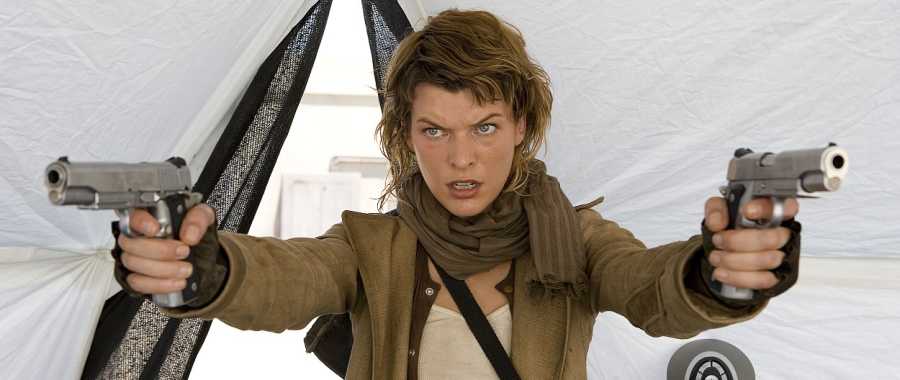 ★★★
★★★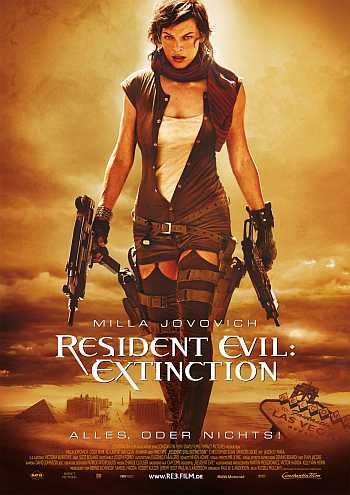 Has it really been three years since the last installment? Guess so. Therefore, about time for the most durable of the video-game to movie franchises, to pop up with another entry. Things continue to go from bad to worse as far as Planet Earth is concerned, with the T-virus, which spread from the complex to Raccoon City last time, now infecting the entire world. A few survivors roam the wastelands, such as in a convoy led by Claire Redfield (Larter), unable to stay in one place too long, because the zombies will locate them. Meanwhile, Dr. Isaacs (Glen) is working on reversing the virus, or at least making the zombies docile – though his approach to scientific teamwork leaves a little to be desired, shall we say. He also has a pit where he disposes of his raw material, an aspect that reminded me of the original Aeon Flux short films.
Has it really been three years since the last installment? Guess so. Therefore, about time for the most durable of the video-game to movie franchises, to pop up with another entry. Things continue to go from bad to worse as far as Planet Earth is concerned, with the T-virus, which spread from the complex to Raccoon City last time, now infecting the entire world. A few survivors roam the wastelands, such as in a convoy led by Claire Redfield (Larter), unable to stay in one place too long, because the zombies will locate them. Meanwhile, Dr. Isaacs (Glen) is working on reversing the virus, or at least making the zombies docile – though his approach to scientific teamwork leaves a little to be desired, shall we say. He also has a pit where he disposes of his raw material, an aspect that reminded me of the original Aeon Flux short films.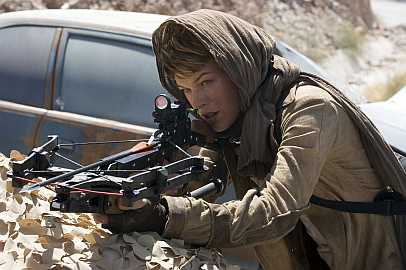 The main problem, I feel, is that giving Alice mental powers detracts from the physical side of action, which has always been a major part of this series’s appeal: watching Jovovich kick zombie butt. The Las Vegas battle is unquestionably the highlight of the film as far as that goes, with Alice adopting a no-nonsense, slice-and-dice approach, that’s a gleeful joy to watch. After it, however, things go somewhat wonky: the entire Redfield subplot is airily waved away, and then there’s the inevitable boss level fight – this time against the Tyrant [if you’ve played the games, you probably know what that is, which puts you one-up on me], a somewhat rubbery, tenticular beast that is not among Patrick Tatopoulos’s best work.
The main problem, I feel, is that giving Alice mental powers detracts from the physical side of action, which has always been a major part of this series’s appeal: watching Jovovich kick zombie butt. The Las Vegas battle is unquestionably the highlight of the film as far as that goes, with Alice adopting a no-nonsense, slice-and-dice approach, that’s a gleeful joy to watch. After it, however, things go somewhat wonky: the entire Redfield subplot is airily waved away, and then there’s the inevitable boss level fight – this time against the Tyrant [if you’ve played the games, you probably know what that is, which puts you one-up on me], a somewhat rubbery, tenticular beast that is not among Patrick Tatopoulos’s best work. Things do perk up at the very end. As in the first two films, there’s a grand final shot, which leaves you eagerly anticipating the next part – in this case, presumably called Resident Evil: Globapocarnarmagediediedie. Certainly, I wouldn’t be
Things do perk up at the very end. As in the first two films, there’s a grand final shot, which leaves you eagerly anticipating the next part – in this case, presumably called Resident Evil: Globapocarnarmagediediedie. Certainly, I wouldn’t be 










 ★★★★
★★★★
 The tactic here was simple and clear. Keep all the good stuff from the original, e.g. Milla Jovovich, zombie dobermans, and throw a few new elements in, this time including some stuff which, unlike Jovovich’s character, Alice, actually has a significant connection to the game. Hence, you get Jill Valentine (Guillory), a special forces chick who, in most other movies, would be the heroine, but is here largely to show you how Alice v2.0 has been improved beyond human. It’s reminiscent of how Ripley, by Alien Resurrection, had partly been transformed into what she was fighting, and Alice is now faster, stronger and cooler than she was last time – which is something of an achievement in itself.
The tactic here was simple and clear. Keep all the good stuff from the original, e.g. Milla Jovovich, zombie dobermans, and throw a few new elements in, this time including some stuff which, unlike Jovovich’s character, Alice, actually has a significant connection to the game. Hence, you get Jill Valentine (Guillory), a special forces chick who, in most other movies, would be the heroine, but is here largely to show you how Alice v2.0 has been improved beyond human. It’s reminiscent of how Ripley, by Alien Resurrection, had partly been transformed into what she was fighting, and Alice is now faster, stronger and cooler than she was last time – which is something of an achievement in itself. Or at least, mostly solidly – let’s get the criticism out of the way first. Witt wants to stick the camera right in there, when what we want to do is fully appreciate the grace and athleticism of the heroines, not suffer from motion sickness. Also: hello, “R”-rating? Presumably this was for the language, topless undead hookers, and Milla’s scarily-large nipples (Chris pointed out they’re almost larger than her breasts), because it certainly wasn’t for the gore. These monsters were almost bloodless, even when shot through the head or exploded by hand-grenade – the latter would seem dangerous when you’re dealing with a highly-infectious, fluid-borne disease, but I’m quibbling here.
Or at least, mostly solidly – let’s get the criticism out of the way first. Witt wants to stick the camera right in there, when what we want to do is fully appreciate the grace and athleticism of the heroines, not suffer from motion sickness. Also: hello, “R”-rating? Presumably this was for the language, topless undead hookers, and Milla’s scarily-large nipples (Chris pointed out they’re almost larger than her breasts), because it certainly wasn’t for the gore. These monsters were almost bloodless, even when shot through the head or exploded by hand-grenade – the latter would seem dangerous when you’re dealing with a highly-infectious, fluid-borne disease, but I’m quibbling here.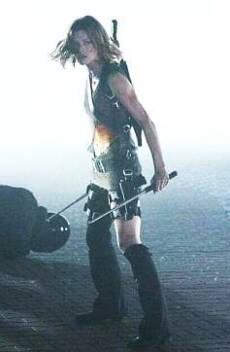 As mentioned, the undead attack canines are also back, and just as bad as before; this time, it’s mostly Valentine who has to deal with them, at least until the end, when Alice effortlessly one-ups her rival yet again. We briefly muttered “catfight!” under our breath, and it’d certainly have been fun to see Jill and Alice go toe-to-toe, but the outcome of that would be so predictable – Alice would win, without even breaking sweat – that its omission is understandable. The supporting characters do their job adequately; Mike Epps is the comic relief, something not really present in the first film, and manages the tricky task of doing the job without becoming annoying. Oded Fehr is somewhat irrelevant as a soldier also after the scientist’s daughter, while Sandrine Holt, playing journalist Terri Morales, is understandably overshadowed by Jill and Alice. On the Umbrella side…blah evil corporate drone, blah misunderstood scientist blah, blah. We don’t care – and nor should we.
As mentioned, the undead attack canines are also back, and just as bad as before; this time, it’s mostly Valentine who has to deal with them, at least until the end, when Alice effortlessly one-ups her rival yet again. We briefly muttered “catfight!” under our breath, and it’d certainly have been fun to see Jill and Alice go toe-to-toe, but the outcome of that would be so predictable – Alice would win, without even breaking sweat – that its omission is understandable. The supporting characters do their job adequately; Mike Epps is the comic relief, something not really present in the first film, and manages the tricky task of doing the job without becoming annoying. Oded Fehr is somewhat irrelevant as a soldier also after the scientist’s daughter, while Sandrine Holt, playing journalist Terri Morales, is understandably overshadowed by Jill and Alice. On the Umbrella side…blah evil corporate drone, blah misunderstood scientist blah, blah. We don’t care – and nor should we.




































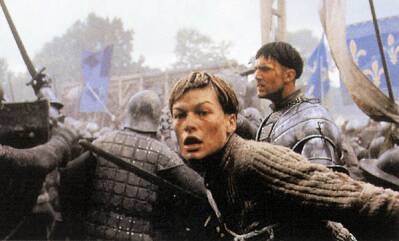 Joan’s capture, trial and execution are fairly close to the truth, though in reality, the King was less involved and more concerned for Joan than shown. It certainly is reasonable to suggest that a naive innocent such as Joan would have been used for political ends. Once she’d outlasted her usefulness – and with the king on the throne, she quickly became more a hindrance than a help – she would have needed to be disposed of. Must confess, I quite like the concept of Joan as a medieval version of Lee Harvey Oswald. Dustin Hoffman’s appearance as Joan’s conscience is another neat touch, and his sarcasm works well. Indeed, the film is one good performance from being excellent. The bad news is, it’s Jovovich who is the culprit (a messenger who deserves to be shot?), though Besson and co-writer Andrew Birkin perhaps warrant most of the criticism for twisting facts and characters in order to fit a predetermined goal. Their Joan is so far from the historical record, they’d have been better off placing their character in an entirely fictitious setting.
Joan’s capture, trial and execution are fairly close to the truth, though in reality, the King was less involved and more concerned for Joan than shown. It certainly is reasonable to suggest that a naive innocent such as Joan would have been used for political ends. Once she’d outlasted her usefulness – and with the king on the throne, she quickly became more a hindrance than a help – she would have needed to be disposed of. Must confess, I quite like the concept of Joan as a medieval version of Lee Harvey Oswald. Dustin Hoffman’s appearance as Joan’s conscience is another neat touch, and his sarcasm works well. Indeed, the film is one good performance from being excellent. The bad news is, it’s Jovovich who is the culprit (a messenger who deserves to be shot?), though Besson and co-writer Andrew Birkin perhaps warrant most of the criticism for twisting facts and characters in order to fit a predetermined goal. Their Joan is so far from the historical record, they’d have been better off placing their character in an entirely fictitious setting.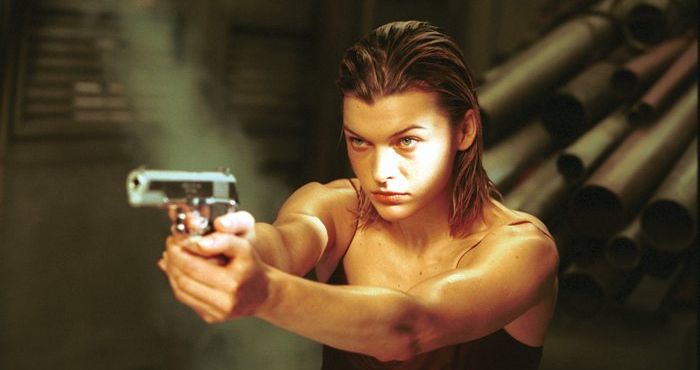
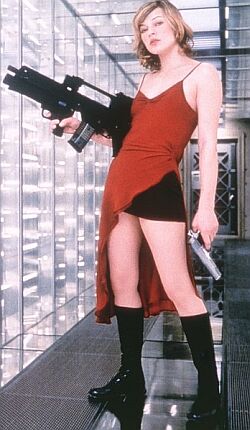 Interestingly, in the past year, all three of the computer-game to movie adaptations have had heroines: Lara Croft, Aki (Final Fantasy), and now, Resident Evil‘s Alice, who wakes up one day with a splitting headache and no memory. I’ve had mornings like that too. However, I never found myself kidnapped by a SWAT team and dragged into the Hive, an underground complex populated by the walking dead (human
Interestingly, in the past year, all three of the computer-game to movie adaptations have had heroines: Lara Croft, Aki (Final Fantasy), and now, Resident Evil‘s Alice, who wakes up one day with a splitting headache and no memory. I’ve had mornings like that too. However, I never found myself kidnapped by a SWAT team and dragged into the Hive, an underground complex populated by the walking dead (human 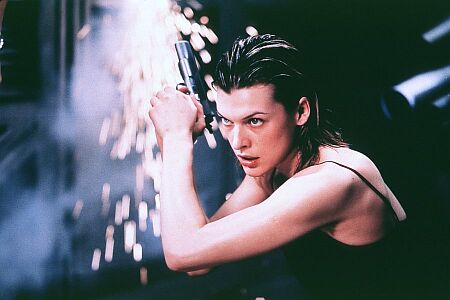 This is to…er, well, I think it was to disarm the computer, but I’m not certain about that. Mind you, I’m not certain about quite a lot in this movie. The characterisation is so woeful, I managed to combine two opposing characters into one for the entire film. And it still made sense – indeed, even after Chris enlightened me, I felt my version was better. My version would also have discarded the clock countdown, or used it as the basis for an exciting race against time through the tunnels. What’s the point of a countdown, if you don’t see it in the last ten minutes? There’s also maddeningly shallow nods to Lewis Carroll: the heroine is called Alice, who goes down a “rabbit hole”, while the computer is the Red Queen with a fondness for lopping off peoples’ heads. You should either do this stuff to the hilt, or not at all.
This is to…er, well, I think it was to disarm the computer, but I’m not certain about that. Mind you, I’m not certain about quite a lot in this movie. The characterisation is so woeful, I managed to combine two opposing characters into one for the entire film. And it still made sense – indeed, even after Chris enlightened me, I felt my version was better. My version would also have discarded the clock countdown, or used it as the basis for an exciting race against time through the tunnels. What’s the point of a countdown, if you don’t see it in the last ten minutes? There’s also maddeningly shallow nods to Lewis Carroll: the heroine is called Alice, who goes down a “rabbit hole”, while the computer is the Red Queen with a fondness for lopping off peoples’ heads. You should either do this stuff to the hilt, or not at all.